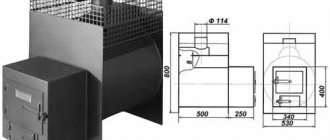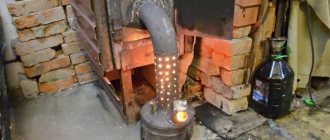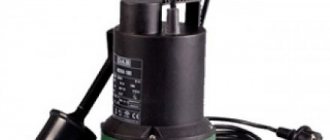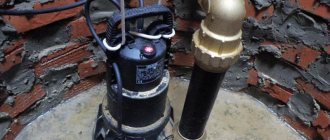Owners of private houses, and sometimes owners of summer cottages, build bathhouses on their plots of land. The most popular are Russian baths and Finnish saunas with a swimming pool. To heat the premises of these buildings, heating is required, since bathing procedures are closely related to water. Water freezes at low temperatures and can subsequently damage pipelines, faucets and other equipment (defrost). Creating an autonomous heating source for a bathhouse entails large financial costs, and besides, installing a boiler for a bathhouse (which usually has a small area) is irrelevant. The best option is to heat the bathhouse from a boiler in the house located on the site.
Boiler or furnace: differences in designs
Sometimes a sauna boiler is called a stove; confusion occurs when it comes to the simplest products that burn wood or briquettes. In reality, boilers are more complex: a stove with a chimney is complemented by a tank for heating water and (sometimes) a heat exchanger.
To maximize the effect of bath procedures, a visit to the bath necessarily includes washing before the steam room and rinsing after it. Installing a tank allows you to get a productive water heating device; however, the modification increases the cost slightly.
The sauna boiler comes with a water tank. It is especially practical where the steam room and washing compartments are combined. It is able to provide rapid heating of water thanks to a heat exchanger. To ensure maximum heat transfer, water circulation occurs in different directions. Structurally, the tank can occupy several positions, but it always makes the most of the potential of the heating equipment.
Construction of a wood stove with a tank Source aviarydecor.com
Heating system
In most cases, continuous burning stoves are installed in bathhouses. which do an excellent job as the main source of heat in the room. At the same time, it is worth immediately making a reservation that for arranging the stove it is advisable to use only cleaned stones, the diameter of which reaches 10 centimeters. To achieve the optimal temperature in the room, it takes at least two hours to heat such a stove, during which you will have to periodically add firewood.
The bathhouse is a wooden building with a high level of humidity in the premises. As you know, wood that is regularly exposed to water can become unusable in a very short time. Because of this, unpleasant odors may appear in the bathhouse, and the building itself will require repairs in the future.
To avoid this, issues related to its quality heating should be resolved in advance. At the same time, it is advisable not to limit yourself to just one stove, but to supplement it with various heating systems, which, moreover, will significantly reduce the time it takes to warm up the premises before taking water procedures.
For safety reasons, in a wet room such as a bathhouse, it is allowed to use one or two heating radiators, which must be connected to the heating system of a residential building. In addition, there are several other options for heating a bath, the choice of which depends only on your requirements and wishes.
Heating radiators in the bathhouse
Design options for sauna boilers
The design differences lie mainly in the method of placing the tank and the volume of heated water. The classification covers four installation methods; they all have their own merits and are equally widespread throughout Russia.
Internal tank
The design, in which the water heating tank is located inside the furnace body, is interesting for the following features:
- There is no access to the tank from the outside; it is not visually visible. In most cases, the solution is typical for factory models.
- The internal location ensures maximum water heating speed when compared with other varieties. The container is in direct contact with the combustion chamber; Additionally, the housing prevents heat from leaking out.
- As a rule, such models have a small (25-30 l) volume. They are ergonomic, efficient and keep water warm for a long time.
Model with a compact internal tank Source dekoriko.ru
On the chimney, "samovar"
The water reservoir is located on the chimney, in close proximity to the stove (above it). The samovar tank is a practical solution for hot water supply with the following specifics:
- Heating occurs due to exhaust furnace gases, which significantly increases the overall efficiency of the device. The water remains hot both during combustion and for some time after its completion.
- The solution is considered environmentally friendly and economical if you need to organize hot water supply for a periodically used room.
- The water heats up more slowly than in a design with an internal tank, but the heating speed is sufficient for comfortable use. Productivity depends on the power of the stove and the volume of the tank.
- Heating occurs due to the fact that thermal energy comes not only from the walls of the chimney, but also from the metal body.
- The efficiency of the device can be increased: the closer the tank is located to the furnace (the source of hot furnace gases), the faster the water temperature rises.
Medium volume samovar tank Source prom.st
- The design is reliable, easy to install and maintain. The tank is made of stainless steel and has a rectangular or round shape (at the base).
Remote with heat exchanger
The steel tank is located outside the sauna stove, but is connected to it by a heat exchanger built into the firebox. The system can be described as follows:
- The flame in the firebox first heats the coolant in the heat exchanger (a water circuit built into the firebox), and only then heats the water in the tank.
- There are no restrictions on tank volume in the design. The heat exchanger coil is built directly into the firebox.
- The presence of an intermediate link is the reason for the rather slow rate of increase in water temperature (the slowest of all options).
- High-quality heat-resistant steel is used to manufacture the remote tank. The volume is selected based on the size of the room, usually 35-80 liters. Containers of increased volume (60-80 l) can be angular.
- In order for the water circuit to work with maximum efficiency, the tank is not moved more than 2.5 m from the stove.
Design with a remote tank Source aviarydecor.com
- Despite the slow heating, the remote design is popular. The fact is that if you install it in the washing compartment, you can additionally heat the room.
- The full heating time is affected by the volume of the container and the external temperature. With a volume of 80 liters, heating will take approximately 2.5-3 hours.
See also: Catalog of companies that specialize in engineering systems (heating, water supply, sewerage and others) and related work
Mounted (a type of remote)
A mounted boiler in a bathhouse has the following advantages:
- The metal container is attached to the furnace body, on the side or back, rigidly or using special connectors. Close proximity is the main feature of the design.
- Contact with the hot furnace body (steel, cast iron or brick) ensures a rapid increase in the temperature of the coolant.
- The design is simple in design and installation. It is manufactured as a separate component, so you can refuse to use it if you wish.
- Disadvantage of a metal tank: it is located near people, which increases the likelihood of careless touching and burns.
Wood-burning stove with a hanging tank Source oteplicax.ru
Criterias of choice
The main indicators that must be taken into account when choosing a stove are the following:
- mechanism of action;
- manufacturing materials;
- fuel.
Baths can be heated using permanent or temporary (periodic) stoves. The first ones need to be kept burning the entire time the steam room is in use. For the second, preliminary high-quality heating is enough.
The range of materials from which a heater can be made now includes a large number of traditional and new technological elements.
The best stoves are made of steel and brick.
Brick structures
The leaders in demand are heaters made of periodic bricks. Continuous combustion heaters are also used to provide heating for saunas. but much less often.
Brick kilns of intermittent operation have both an advantage - they maintain a high temperature in the room for a long time, and a disadvantage - they need to be warmed up for at least 5 hours. In winter this takes even longer. Therefore, if bathing procedures are planned for the evening, then you need to start heating in the afternoon. After this, you can steam and not be distracted by other things, the heating will work without outside interference.
There is another disadvantage of such models - high cost. It is quite difficult to make such a heater yourself. To get a truly functional stove, you need an experienced stove maker. And his work is highly paid. The high cost of the heating structure can also be explained by the fact that it is necessary to lay a powerful foundation that will support a heavy brick heater.
Metal heat sources
Metal furnaces are characterized by the principle of constant operation. A stove with thin steel walls does not retain heat for long, which can be attributed to its disadvantages. And the advantage of a metal sauna stove is that it will take much less time to warm up the room.
In winter, this will take no more than 2 hours. It is better to organize heating using a steel heater in a small bathhouse. You can install the stove yourself.
Types of boilers by type of energy carrier
Most private baths are modest in size and heated using a simple wood stove, often supplemented by a water tank. Wood-burning sauna boilers are classified as solid fuel units. The boiler is installed simultaneously with the stove during the construction of the bathhouse. Wood-burning models are often the work of their owners, unlike devices that run on another type of energy source.
Electric boilers
They are designed for heating any premises: country houses, apartments, dachas and other objects. The operating principle of an electric boiler is the same as that of a boiler. By design, there are two-circuit boilers (they simultaneously heat and supply hot water) and single-circuit boilers (they exclusively heat).
Compared to units using other types of fuel, electric boilers are safer and operate silently in automatic mode. They are distinguished by their neat dimensions and light weight. The advantages include simpler and cheaper connection, simpler operation. Most models are wall-mounted; they do not need a personal boiler room; installation is possible in any room.
Model of an electric boiler with a water tank Source teplodar.ru
For use in bathhouse conditions, it is important that electric boilers do not create harmful emissions; they do not require regular cleaning and the purchase of fuel. Despite its obvious environmental friendliness, an electric unit is far from the most successful option for a bathhouse; They are rarely used for the following reasons:
- High energy consumption.
- High demands on network stability, as well as on the quality and reliability of electrical wiring.
An electric boiler is chosen if the bathhouse is located in the basement of the house or adjacent to it. In a free-standing bathhouse, limit yourself to a boiler or choose a compact single-circuit boiler to provide hot water supply for the washroom.
Gas
A gas boiler for a bath is becoming a competitor to traditional wood-burning stoves. Installing such a unit is economically beneficial not only in gasified areas. If you want to equip a bathhouse in your country house, but there is no mains for connection nearby, the solution may be a device that can run on liquefied gas rather than natural gas.
Gas boilers are reliable and economical Source 2proraba.com
Electrical
And finally, let’s look at several ways to use electricity to heat a bathhouse. I’ll say right away: take care of the electrics in this case. Since the load on thermal electrical appliances is large, the quality of the electrical wiring should not be in doubt. Consider the total load, wire cross-section, wiring diagram and quality of electrical work.
Firstly, your room can be heated using an electric heater. True, in this case you will have to take care of heating the water in the shower in advance (for example, by installing a direct or indirect heating boiler). This type of heater does not require additional arrangement of the chimney and is considered environmentally friendly.
Secondly, the bathhouse (in particular the relaxation room) can be heated using electric convectors placed on the walls.
Well, thirdly, infrared film can come to your aid - the newest type of heater, which allows you to easily and quickly create warm floors both in the house and in the bathhouse. Detailed technology for installing heated floors is discussed in other articles.
Please note that the installation of heated floors is possible without the use of infrared film, but by laying electric heating cables. They are used both in underfloor heating systems and for heating water pipes. It is quite possible to use infrared heaters as an additional source of heat
Hung it on the ceiling and forgot
It is quite possible to use infrared heaters as an additional source of heat. I hung it on the ceiling and forgot about it.
Using electricity to heat a bath undoubtedly has its advantages. You can safely use all the structural elements (heater, heated floor, boiler) at any time all year round. At the same time, you don’t have to worry about fuel or worry about pipes freezing. The only serious drawback can be considered the high energy consumption.
In the case when you do not often use the bathhouse (especially in winter, rarely coming to the dacha), then the most optimal option would be a mixed heating device. For example, a stove is installed and electric heating is installed. If you decide to take a shower, rest or “stretch”, use electricity. If you decide to take a steam bath “like an adult”, turn on the stove thoroughly.
Remember. Whatever the heating in the bathhouse, if you do not use it constantly in winter, then be sure to drain the water from boilers, water heaters, pipes, toilet tank (if there is one), etc. This is guaranteed to protect them from damage, and you from unnecessary headaches.
Heated floor control unit
Making a wood boiler
If you know how to use a welding machine, an angle grinder and have spatial imagination, a homemade boiler for a bathhouse can be a budget alternative to purchased models. Self-assembly does not involve complex techniques and does not require expensive materials.
Diagram of a boiler with a water circuit Source sitysun.ru
Safety and Installation Requirements
Since gas is used for operation, you should be as careful as possible during operation.
Necessary:
- monitor the wear of all equipment parts;
- regularly check the readings of the gas analyzer and other devices;
- Only trust a specialist to replace parts.
Savings when purchasing, installing and operating gas equipment can lead to dire consequences.
Requirements for the room where gas equipment is planned to be installed: no high humidity, no accumulation of dust, limited access for children.
Before a gas boiler room is installed in a sauna or bathhouse, you need to study the rules for safe installation:
- the height of the room must be at least 2.2 m;
- All doors must be opened outwards;
- It is necessary to have a window and exhaust ventilation;
- absence of flammable structures near the equipment (minimum distance - 0.5 m);
- if the walls of the room are made of fire-hazardous material, when installing the equipment, an indentation of at least half a meter should be made (the use of a fire-resistant barrier or heat-resistant screen is allowed);
- a hole for a rectangular burner (height - 48-55 cm, width - 35-45 cm);
- to prevent gas leakage, it is recommended to install a special sensor that will operate when the burner goes out;
- the smoke exhaust pipe should not pass through living rooms;
- the stove must have a metal base that will protrude at least 10 cm;
- To prevent the occurrence of condensation, the chimney must be made of stainless steel.
If the site is not gasified, then forced removal of combustion products should be organized. To maintain high temperatures, high-quality thermal insulation of the room is necessary.
The optimal solution would be to use foil insulation. It should be noted that heat loss increases in the presence of windows and uninsulated doors.
How to choose a boiler for a bath or sauna
If you find it difficult to determine what tank size will be optimal for the conditions of your bath, it is useful to use the following considerations:
- To steam one broom, it takes at least 10 liters of hot water, for two you will need 20 liters.
- For comfort, every connoisseur of bath procedures needs at least 15, and preferably 20, liters of heated water.
If a company of four people gathers, then the tank volume should be at least 80 liters (based on two brooms).
For the unit to operate efficiently, it is also important to take into account personal needs and correlate them with the following parameters:
- Dimensions and power of the boiler, what volume of the steam room it is designed for.
- From which room according to the project will the steam room be heated?
- Materials of the device, especially the housing.
- Type of heater, volume of stones.
- If you are planning a gas bath, one of the criteria will be gas pressure, as this is important for the safe operation of the device.
- Will you line the container with stone, tile or brick to better retain heat and protect you from burns.
Modern oven with a heat exchanger and an external tank Source ukr.bio
Laying pipelines from the house to the bathhouse
Pipeline from the house to the bathhouse
Laying heating lines to the bathhouse is carried out in two ways:
- External (open);
- Underground (hidden).
External laying is used when the distance to the bathhouse is small - in this case, the construction of numerous supports, which are unnecessary elements on the site, is not required. When laying externally, pipelines are insulated and laid with a slope to free them from water.
The main method of laying heating pipelines is underground. The choice of material is carried out subject to special operating conditions - inaccessibility and absence of connections (hidden). The best choice is polymer pipelines. Pipes made of polyethylene (cross-linked), metal-plastic, polypropylene are laid on a sand cushion in an open trench, then buried.
The depth of the trench—the point where the pipes will be laid—must be below the freezing point of the soil for a particular region. The freezing depth is determined from the reference book. Pipelines do not need to be insulated by using protective material - fiberglass and other types of material with similar characteristics.
Briefly about the main thing
Many owners of baths and saunas consider it optimal to use a boiler, that is, a stove supplemented with a water tank. This combination is practical and functional; it provides not only hot water supply for any bath processes, but also helps to heat the premises.
There are several ways to position the tank, based on whether it will be built-in or external. To a large extent, the choice of boiler model is influenced by whether gas, electricity or wood will be used as fuel. The volume of the tank is selected depending on the number of users.
Ratings 0
Rating of the TOP 10 best gas stoves for baths in 2021
| Place | Name | Price |
| TOP 5 best gas stoves for baths by price/quality for 2021 | ||
| 1 | TMF Taimyr XXL 2021 Inox | Find out the price |
| 2 | Vesuvius Skif Forging 18 (DT-3) black | Find out the price |
| 3 | TMF Urengoy | Find out the price |
| 4 | TMF Taimyr 2021 Carbon | Find out the price |
| 5 | Vesuvius Lava 18 (DT-3) black | Find out the price |
| TOP 5 best inexpensive gas stoves for baths | ||
| 1 | TMF Taimyr | Find out the price |
| 2 | Vesuvius Gas-Wood Skif Forging 18 (DT-3) | Find out the price |
| 3 | TMF Taimyr Mini 2021 Carbon | Find out the price |
| 4 | Ermak Uralochka 30 | Find out the price |
| 5 | Ermak Uralochka 36 black | Find out the price |
Sheet iron heating device
A similar stove with a metal boiler for a bathhouse is the most difficult to produce. This is due to the fact that there will be no prepared workpiece. Fundamentally, such a device is no different from the one described above. It also contains 4 compartments: an ash pan, a firebox, a heater and a tank.
The production of such a furnace will take longer. You will especially have to tinker with the water tank, which should be practically sealed. But the result will be a product no different from what was produced at the factory.
How to obtain permission to install equipment
Before starting the construction of a gas-heated bathhouse, it is necessary to check with the relevant services about the possibility of connecting the facility to the gas network. It is made on the basis of an application. Gas services, based on the power of the equipment planned for installation in the baths, calculate the maximum gas consumption m.cub./hour.
Based on this calculation and safety requirements, they develop technical conditions for connecting gas to the facility and issue its passport. After obtaining permission to connect gas, work is carried out by specialized organizations. At the same time, the bathhouse room to which gas is supplied must comply with the requirements of SNiP 2.04.08-87.
Adviсe
- Mikhail (gas service inspector)
Owners of bathhouses who want to install gas stoves to heat them must take into account that such a building must have a solid foundation. The volume of the room for installing the unit cannot be less than 8 cubic meters. m. There must be a passage space next to the stove that is at least 1 m wide. The windows of the bathhouse must open outward and have handles on both sides.
- Vitaly (master gas equipment adjuster)
Small baths with an area of no more than 3x3 m can be equipped with stoves running on bottled gas. Such equipment copes well with the task of heating rooms.











